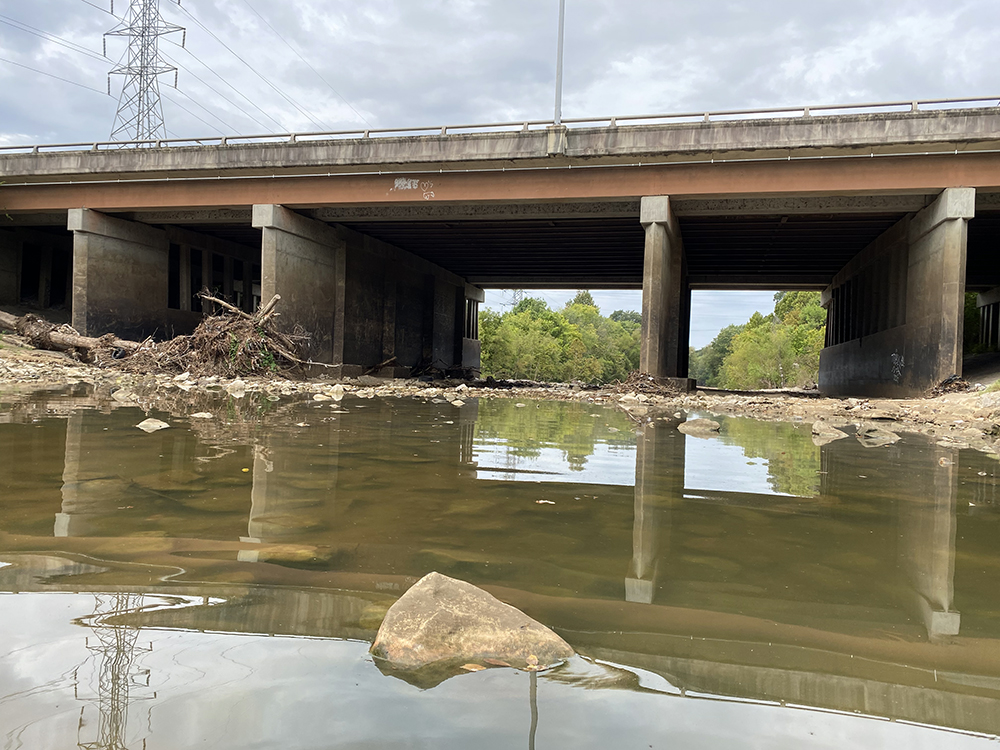I’m sitting in a kayak somewhere between Lamar and Airways Boulevard. There are two barbs from a fishing lure’s rear treble hook embedded in my left calf. The lure’s front treble hook is snagged on the backpack in the bottom of my boat. To simplify, I am attached to my backpack by a fishing lure. It hurts. A lot. I’m too tired to panic, but I am starting to wonder why I am here — and how I will get out.

How It Started
It’s a story that began with a simple pitch to my editor: I’ll float Nonconnah Creek from somewhere in East Memphis all the way to McKellar Lake. It will be a quirky lark, and it could be interesting to see what I find in and along the Wolf River’s unsexy sibling, a creek that follows I-240 through the southern underbelly of Memphis. A couple freelancers wrote about it for the Flyer a dozen years ago, but things have probably changed since then. I pitched it as a fun urban adventure. He went for it, probably because I’m quite the smooth talker.
While planning my trip, I quickly learned that getting onto Nonconnah Creek is not an easy thing. There are no access points, no parks, no trails, no obvious spots where you can slide a boat in. After much searching on Google Maps, I finally spotted a nondescript motel near Perkins Road that appeared to have a parking lot that backed up to the creek. When I drove there, I discovered the lot was only 30 feet from the stream, with no fence to impede a launch. I figured it might be dicey if security cameras caught me, but knowing I could be in the water in five minutes made me confident I’d be paddling before anyone could ask questions. I just needed a getaway driver.
For that, I enlisted my stepson, Roman, who cheerfully drove me to the lot around 8 a.m. last Tuesday. It all went off without a hitch — no motel gendarmes, no hassles — as we schlepped my kayak down to the creek. I tossed in a backpack filled with four cans of water, three power bars, two bananas, a rain jacket, two phone chargers, sunscreen, and a small box of fishing lures. And I stuck a spin-casting outfit in the rod holder.
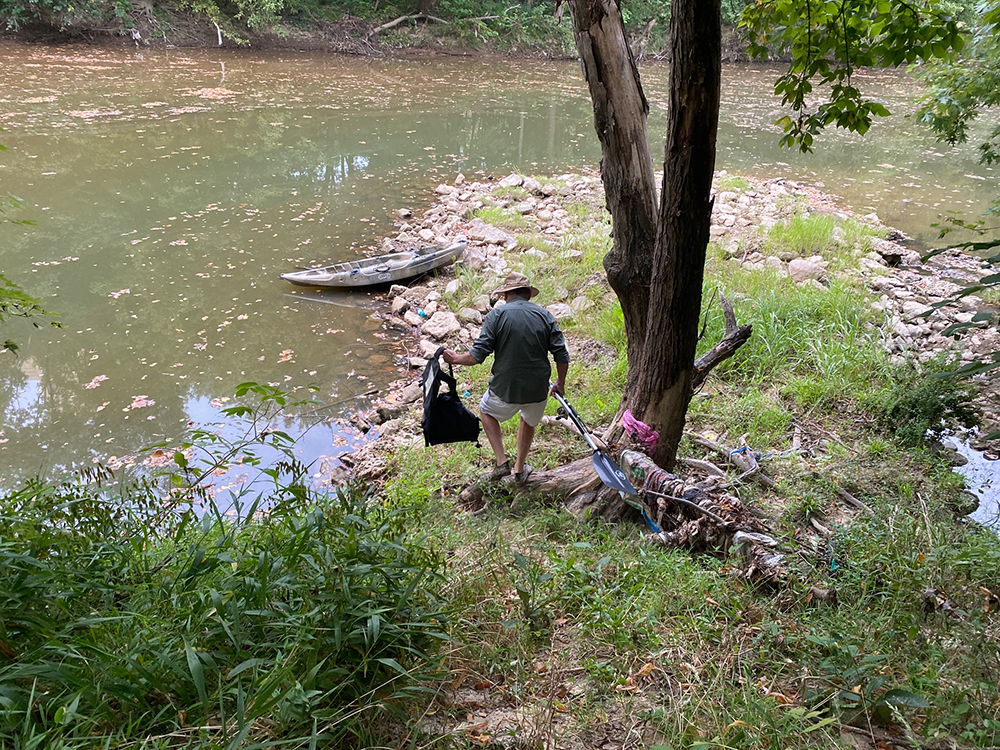
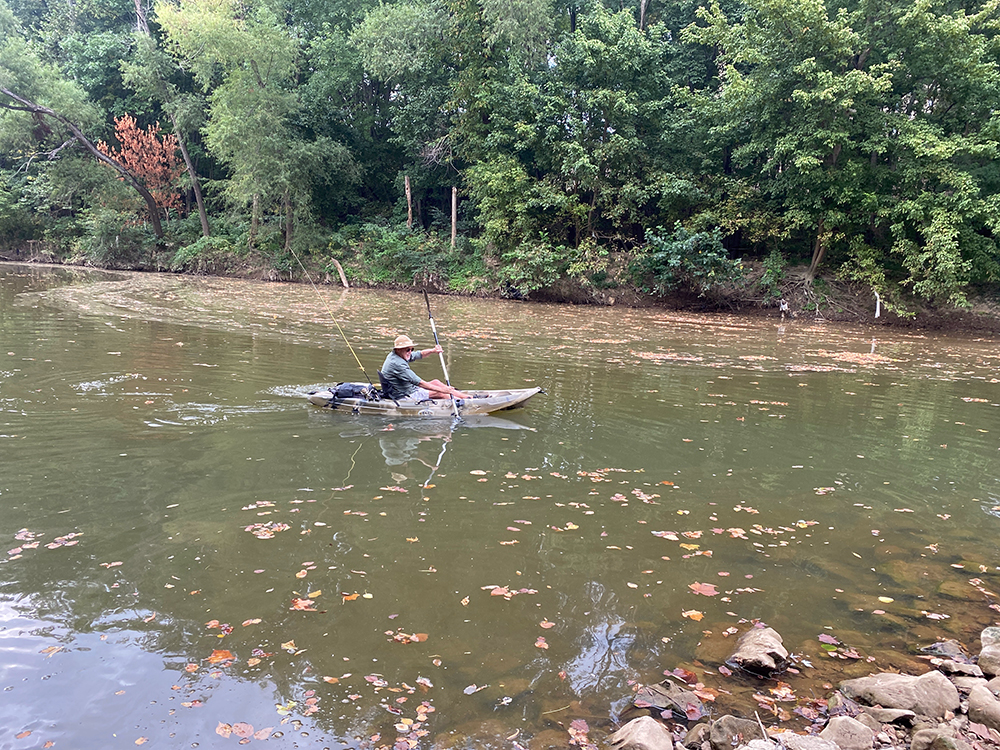
As I waded in and pushed off, Roman snapped some pics. McKellar Lake was 11 miles away. I told Roman I’d meet him at the Riverside boat ramp in Martin Luther King Jr. Park, probably around 2 o’clock, figuring on a leisurely two-miles-an-hour paddle, including time to dawdle and fish and take pictures. Piece of cake.
“I’ll text you when I’m near there,” I said. “Thanks for bringing me.”
“Have fun!” he said.
The water was slightly murky at the put-in, three to four feet deep in most places, but you could easily see the bottom. There didn’t seem to be much flow. Wildlife was abundant. Turtles fell like stones from logs. A night heron calmly watched me pass by from a low branch, showing no fear. At the first bend I flushed eight wood ducks and a white egret from a gravel bar. I felt like David Attenborough should be narrating this trip. Except for the plastic bags.
If you aren’t opposed to plastic bags, paddling Nonconnah Creek will change your mind. There’s pretty water and lots of wildlife, but hanging from countless limbs and branches are plastic bags, left during high water, festooning the shoreline like ghostly Halloween decorations. I’ve never seen anything quite like it. Anyway … think about it.

Twenty minutes in, I spotted the Perkins Road bridge ahead — and a massive pile of rocks beneath it, all the way across, dry as dust. I made a note on my phone recorder: “Looks like I’ll have to spend a few minutes dragging the kayak over a pile of rocks.”
Fifteen minutes later, I was finally back in the water on the other side. My shirt was soaked through with sweat. I broke out a can of water and inhaled it. Hopefully, not all the bridges between here and McKellar Lake were going to be like this one, I thought. Mentally counting, I could think of eight: Getwell, Lamar, Airways (two), Nonconnah Road, I-55 (at least two), and Highway 61. Yikes. Surely the water will get deeper, I hoped, knowing if it didn’t, I could be in for a very long day.
How It’s Going
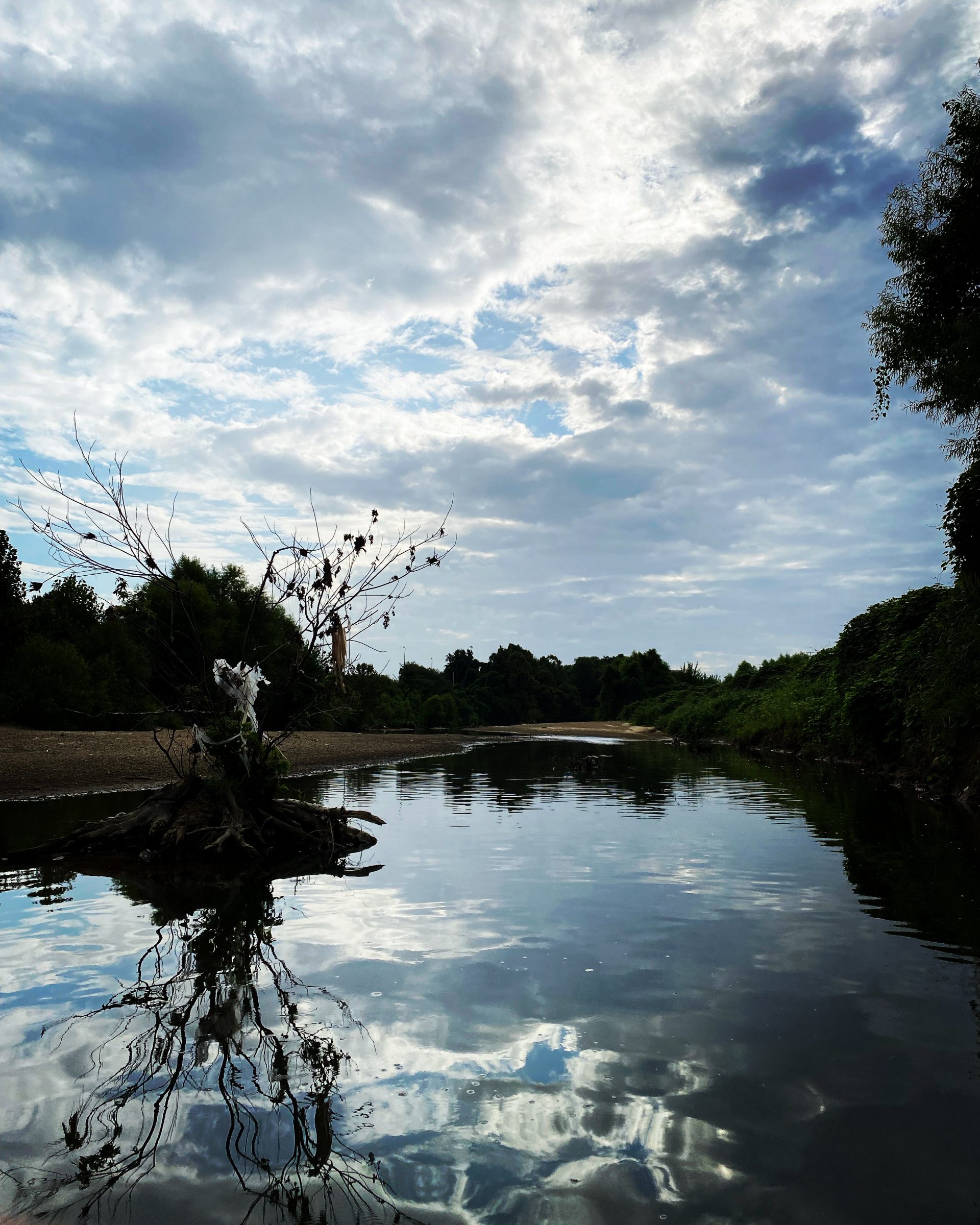
The creek between the Perkins and Getwell bridges had pools of paddle-able water interspersed with a shallow channel snaking between gravel bars that I had to wade, pulling the kayak behind me. It was beginning to dawn on me that I should have checked the creek’s water level more thoroughly than I did. It had seemed fine at the motel lot. Downstream, it appeared, not so much. I was spending more time wading than paddling. After one exhausting 10-minute drag, feet going six inches into the mud with every step, I came to a long, deep pool — no gravel bar in sight. The Google map said I was getting near the Getwell bridge. I plopped into the kayak with a sigh of relief and began to paddle.
I spotted some minnows being chased in the shallows, so I tossed a small Rapala lure near the nervous water. It was immediately whacked by a 10-inch largemouth, which jumped and ran and finally slipped the hook. I cast again and hooked another bass, which I got to the boat and released. My mood improved immensely. Finally, I was paddling and catching fish, just as I’d hoped I would be. Things were looking up. A great blue heron glided past. Surely a good omen. Nope.
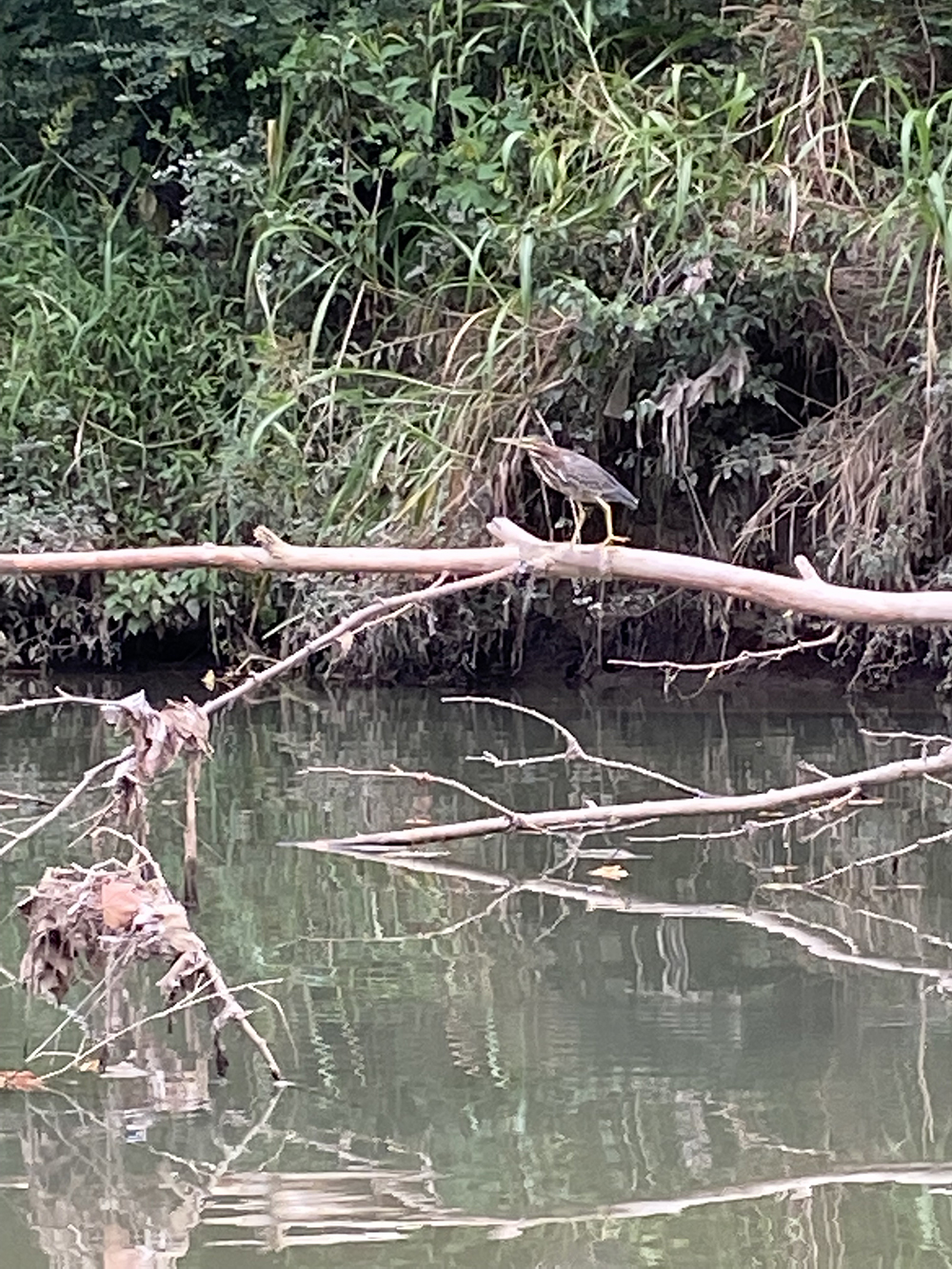
The Getwell bridge was another nightmare — 50 yards of arduous rock-pile leading to a drop of three feet into the next pool. Beyond that pool, 100 yards downstream, I could see an immense gravel bar. I was beginning to understand that reaching McKellar Lake was probably not in the cards. I’d been on the creek for almost three hours and was approximately one-sixth of the way there. At this low water level, Nonconnah wasn’t a stream. It was a series of still pools and gravel bars.

I pulled out my phone and looked at the Google map. The next two bridges were quite a ways downstream — first Lamar, then a mile or so later, Airways — both busy, multi-lane highways. Even if I could somehow drag an 80-pound kayak up to either road, there was no place to wait for pickup. I was beginning to realize that Nonconnah Creek was going to be just as hard to get off of as it was to get onto.
Just past Airways on the map was Nonconnah Boulevard, a smaller road — not a highway — as I recalled. After that, it was a long way to the next bridge. Nonconnah Boulevard would have to do, somehow. I texted Roman and told him the new plan and that I’d call when I got there.
There was a sense of relief in the decision. The goalpost had been moved closer, and I was halfway there. Making things better was the happy discovery 20 minutes later that the bridge at Lamar had no rock-pile. I paddled blissfully under the road, thanking the stream gods as the pools seemed to grow longer and the sandbars fewer. An osprey, chased by two kingfishers, skirted the treetops.
Welcome to the Hotel California
It was early afternoon and I was thinking writerly thoughts — about how I might reconfigure my Nonconnah Creek story in light of the fact that it had changed from a fun float to McKellar Lake to a grueling slog about a fourth of that distance. I was thinking about fresh headlines: “Nonconnah? Not Gonna!” Or maybe, “Nonconnah, the Hotel California of Creeks.” Because, you know, you can check out any time you like, but you can never leave.
Like that.
Still, I was feeling better, a burden lifted. I was paddling more than I was wading, and I only had another hour or so to go, with any luck. I slammed another can of water, ate a banana, and decided, what the hell, why not fish?

I will say this about the stretch of Nonconnah Creek between Lamar and Airways: It has very good fishing. I caught one feisty bass after another. I was actually enjoying the day again. After a few hundred yards of this, I tossed the Rapala near a submerged log about 30 feet away and was startled by a huge eruption. The biggest fish I’d seen so far lunged to the surface but missed the lure. Hurriedly, I tossed the Rapala back to the same spot and jerked it a couple of times. It got stuck on the log underwater. Dammit. I gave the rod a hard jerk and watched the Rapala shoot like a bullet into the kayak, simultaneously hooking my calf and my backpack.
There are moments in life when something so ridiculous happens so suddenly you don’t realize its import. It takes a minute. I sat there observing the absurdity of my situation, unable to move without making it worse, stuck in the middle of a creek with no one around to help or commiserate with me — or even laugh about it.
In this situation, as any fisherman will tell you, there are two basic options. One is to force the embedded hook-points out through the skin, flatten the now-exposed barbs with a pair of pliers, and then slide the hooks back out. The other is to just rotate the hooks as far back out as possible, then jerk them out the rest of the way, barbs be damned. I didn’t have any pliers, so option two was pretty much it.
I used my pocketknife to cut away the backpack from the other end of the lure. The Rapala hung from my calf, like a leg earring. I paddled to the shore to get firm footing for the coming pain festival. I sat on the gravel, slipped the blade of my pocketknife under the bend in the impaled hooks, took a deep breath, and popped it away from my leg, quick and hard. It hurt, but it didn’t bleed much, and I had a bit of a “fuck yeah, I did that” moment. Then I poured fizzy water on it and ate a power bar and got back to paddling. It looked like I’d been bitten by a tiny rattler.
Nailing the Landing
There were three roads to go under at Airways, but the water was high enough under all three that it made me think that the wading-and-dragging sections were finally behind me. I did note that all three bridges were at least 40 feet above the water and that there were no discernible paths up to the roadways through the undergrowth. I hoped Nonconnah Boulevard would be different, thinking it would be somehow poetic if I could end this misadventure on a street named after the creek I was on.
Twenty minutes later, I was sitting in my kayak on Nonconnah Creek underneath Nonconnah Boulevard. Nonconnah possibly understand the joy I felt when I saw that this bridge was lower, closer to the creek, and that the angle of the terrain to the top was not overgrown and considerably more reasonable than any I’d seen so far. I left the kayak and clambered up the slope, paddle in hand as a walking stick. At the top, just under the bridge itself, I found a flattened grassy road of some sort. Eureka! As I emerged from under the bridge, I surprised three people sitting in the bed of a pickup truck with a gas company logo on it. They looked at me as though I were strange or something. Go figure.
“I need to bring my kayak up from the creek,” I said. “Is there a place around here I can put it until my ride gets here?”
“Sure,” said one of the guys, pointing. “That office building parking lot right there ought to be okay.”
This was the best news I’d had for a while. I went back down to the kayak, texted Roman my location, and laboriously dragged the boat up the slope to the parking lot. It was 3 p.m. I’d been on Nonconnah Creek for seven hours and gone about four miles, wading and dragging a kayak about half of that distance. I was as exhausted as I’ve been in many a year.
Friends, I do not recommend this float to you, unless the water level is at least a foot higher. And even at that, I recommend you start at Lamar, where the creek gets a bit deeper and the fishing is good, and you can get out in fairly short order. This is not a stream to mess around with. Take it from someone who messed around with it.
